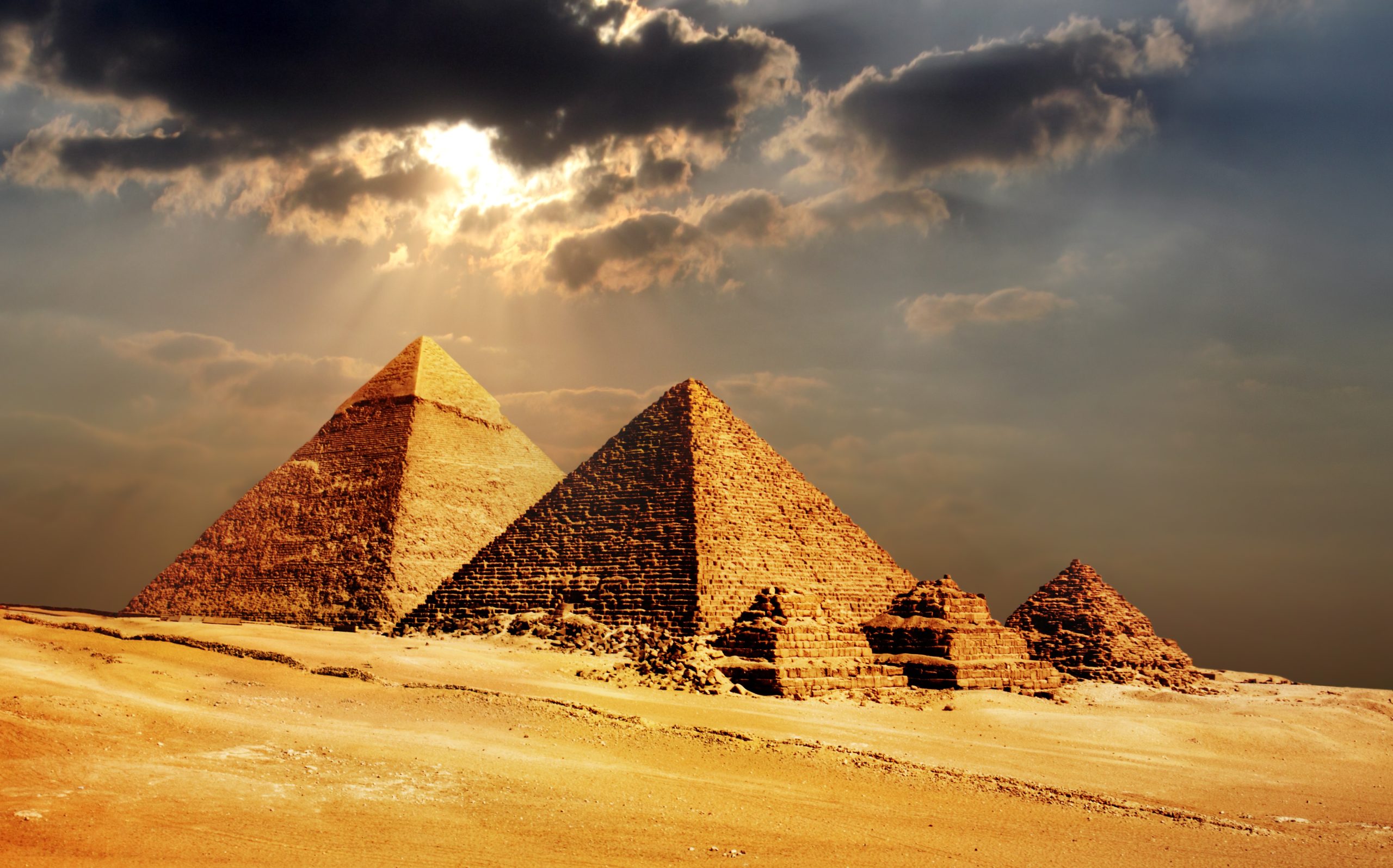Beyond the Pharaohs: 10 Intriguing Facts About the Pyramids of Giza

When you think of Egypt, the majestic Pyramids of Giza undeniably come to mind, standing as eternal symbols of a civilization that has fascinated the world for millennia. These architectural marvels, built thousands of years ago, continue to captivate historians, archaeologists, and travelers alike with their sheer size, precision, and the mysteries that shroud them.
The Pyramids of Giza are not only monumental tombs of Pharaohs but are also a testament to the ingenuity and vision of ancient Egyptian culture. They reflect a society that was advanced in its knowledge of astronomy, engineering, and art.
The significance of these pyramids extends beyond their function as royal sepulchres; they are a lasting legacy of human achievement and an emblem of ancient Egypt’s contribution to world heritage.
Join us as we explore the history, myths, and the less-known aspects of these fascinating structures in our blog post, “Beyond the Pharaohs: 10 Intriguing Facts About the Pyramids of Giza.”
1. The Origin of the Pyramids
The enigmatic Pyramids of Giza, serving as the eternal resting places for Pharaohs, were constructed by a civilization whose engineering capabilities were far ahead of their time.
The most widely accepted theory among Egyptologists is that these pyramids were built by thousands of skilled workers and laborers under the orders of the Pharaohs themselves.
Specifically, the Great Pyramid, also known as the Pyramid of Khufu or Cheops, is attributed to the reign of Pharaoh Khufu, dating to around 2580–2560 BCE during the Fourth Dynasty of the Old Kingdom of Egypt.
This period marks a golden era of pyramid construction, showcasing not only a remarkable understanding of mathematics and astronomy but also a highly organised society capable of mobilising a vast workforce for decades-long projects.
The construction of these pyramids is a testament to the ancient Egyptians’ architectural brilliance and their enduring dedication to their rulers and gods.
2. The Architectural Marvel
The Pyramids of Giza are a testament to the remarkable engineering skills of the ancient Egyptians. Constructing these monumental structures required innovative techniques, some of which continue to puzzle modern engineers and archaeologists today.
For instance, the precise manner in which the massive limestone blocks, each weighing an average of 2.5 tons, were transported and assembled remains a subject of debate and admiration.
Notably, the pyramids were built without the use of the wheel or iron tools, relying instead on copper tools, wooden sledges, and perhaps even a sophisticated understanding of the principles of leverage. Furthermore, the alignment of the pyramids with celestial bodies underscores the ancient Egyptians’ advanced knowledge of astronomy.
The Great Pyramid of Khufu, in particular, is aligned with remarkable precision to the cardinal points of the compass. It is believed that this alignment was intended to serve spiritual or ceremonial purposes, connecting the pharaohs with the heavens.
Such feats demonstrate the ancient Egyptians’ extraordinary capabilities in engineering and their deep connection to the cosmos, combining to create these architectural marvels that have stood the test of time.
3. The Purpose of the Pyramids
While the primary function of the Giza pyramids as monumental tombs for pharaohs is well-known, their roles extend far beyond mere burial sites. These ancient marvels served multiple purposes that underscore the complexity and depth of ancient Egyptian civilisation.
Beyond their sepulchral function, the pyramids were also conceived as part of a larger spiritual and cosmic framework. They were not only gateways to the afterlife for the kings and their consorts but also played a crucial role in the religious life of the people.
The pyramids, alongside their associated temple complexes, were sites of worship and veneration, where priests conducted rituals to honour the deceased rulers and ensure their passage into the afterlife. Furthermore, the pyramids symbolised the pharaohs’ divine power and their role as intermediaries between the gods and the people, reinforcing the social order and the state religion.
The careful alignment with celestial bodies further highlights their astronomic and calendric significance, marking them as timeless observatories that connected the earthly with the divine. In essence, the pyramids of Giza were multifaceted symbols of political power, religious devotion, and cosmic order, embodying the ancient Egyptians’ aspirations for eternity.
4. The Lost Pyramidion of Khufu
Among the many enigmas surrounding the Great Pyramid of Khufu, the mystery of the missing capstone, or pyramidion, stands out. Traditionally, a pyramidion is a miniature pyramid that serves as the capstone of a pyramid or obelisk, often covered in gold to reflect the sun’s rays.
Despite extensive historical records and archaeological findings, the ultimate fate of Khufu’s pyramidion remains a topic of speculation and intrigue. Some theories suggest it was never added, while others propose it was made of gold or electrum and looted in antiquity.
The absence of this crowning piece adds a layer of mystique to the Great Pyramid, fueling debates and hypotheses among historians and archaeologists. This lost pyramidion not only represents an unfinished chapter in the pyramid’s history but also highlights the broader theme of impermanence and mystery that shrouds ancient civilizations.
5. The Great Pyramid’s Hidden Chambers
Recent advancements in technology have unveiled the shadows cast by the Great Pyramid for millennia, revealing secrets that have long eluded archaeologists.
The discovery of hidden chambers within the Great Pyramid of Khufu has been one of the most exhilarating revelations in recent years, facilitated by non-invasive technologies such as muon radiography.
This technique, which detects muon particles from cosmic rays that can penetrate the pyramid’s thick stone, has provided evidence of voids or chambers that were previously unknown. These findings not only add a fascinating chapter to the pyramid’s story but also underscore the ancient Egyptians’ architectural ingenuity.
The purpose of these chambers remains a subject of intense speculation and study, ranging from theories about their role in the construction process to more esoteric interpretations related to the pharaohs’ journey to the afterlife.
This intersection of ancient wisdom and modern science continues to peel back the layers of one of human history’s most iconic monuments, breathing new life into our understanding of ancient Egyptian civilization.
6. The Pyramid Complex
Surrounding the monumental pyramids, the Giza plateau is home to a complex array of structures that play critical roles in the grand scheme of this ancient architectural marvel. Among these, the Sphinx holds a place of prominence, guarding the plateau with its enigmatic presence.
This colossal limestone statue, with the body of a lion and the head of a human believed to represent the Pharaoh Khafre, symbolizes wisdom and strength. Additionally, several smaller pyramids known as satellite or queen’s pyramids reveal the social and familial hierarchies of the time, serving as tombs for relatives of the pharaohs.
The mastabas, flat-roofed and rectangular buildings, provide further insights into the complex, serving as tombs for nobles and high-ranking officials, illustrating the stratification of society even in death.
These surrounding structures, alongside the causeways and temples, such as the Valley Temple and the Mortuary Temple, were integral to the funeral rites and the cult of the pharaoh, establishing a direct link between the divine and the mortal realms.
The totality of the pyramid complex with its surrounding structures offers a comprehensive view into ancient Egyptian life, beliefs, and their pursuit of immortality, standing as a testament to their architectural innovation and spiritual profundity.
7. The Workers’ Village
In unraveling the mysteries of the Great Pyramids, the discovery of the Workers’ Village has provided profound insights into the day-to-day lives of the individuals who constructed these monumental structures. Situated near the Giza plateau, this ancient settlement housed the skilled laborers, artisans, and engineers who dedicated their lives to the creation of the pyramids.
Archaeological findings have debunked the long-held myth that slaves built the pyramids, instead revealing a workforce of well-fed and skilled workers who took pride in their contribution to eternity.
The layout of the Workers’ Village, with its organized streets and community spaces, suggests a highly structured society with a sense of community and purpose. Evidence of medical treatment, including well-used paths to a nearby hospital, indicates the care taken to ensure workers’ health and well-being.
This glimpse into the lives of the pyramid builders not only humanizes the colossal effort behind these ancient wonders but also highlights the advanced social and administrative systems in place thousands of years ago.
Through the lens of the Workers’ Village, we gain a deeper appreciation for the complexity and humanity of ancient Egyptian civilization, showcasing a community united in pursuit of immortality not just for their pharaohs, but in the legacy of their own craftsmanship.
8. Myths and Legends
Among the swirling sands of time and history, the Great Pyramids of Giza have stood as sentinels to both historical truth and fertile myths. One of the most persistent myths is that the pyramids were built by legions of slaves toiling under the crack of the whip.
This image, popularized by Hollywood epics, has been compellingly debunked by recent archaeological discoveries. Evidence uncovered around the Giza plateau, particularly within the Workers’ Village, suggests that the pyramids were constructed by a workforce of skilled laborers who lived in a well-organized community.
These workers were not slaves but paid laborers, who took pride in their work and were provided with food, medical care, and a decent living environment.
This debunked myth not only reshapes our understanding of the pyramid construction project but also illuminates the sophisticated social and administrative structures of ancient Egypt, showcasing a civilization that valued skill, labor, and the welfare of its people in the pursuit of monumental achievements.
9. The Pyramids Today
Today, the Great Pyramids of Giza stand not only as a testament to ancient ingenuity but also as symbols of Egypt’s enduring legacy, drawing millions of tourists from around the globe each year. Their allure is undeniable, offering a tangible connection to the past that is both awe-inspiring and humbling.
However, these ancient structures face modern challenges, including preservation and conservation in the face of environmental threats and the wear of time. Efforts to preserve the pyramids include meticulous restoration projects and the implementation of advanced technologies to monitor their condition and prevent further deterioration.
Despite these challenges, the pyramids continue to thrive as a source of national pride and a pivotal center for archaeological research and tourism. The balance between welcoming tourists and protecting these ancient marvels is delicate, requiring careful management to ensure that they can be enjoyed by future generations.
The allure of exploring these ancient monuments, set against the stark beauty of the Egyptian desert, remains virtually unmatched, offering a glimpse into a civilization that, though long gone, continues to fascinate and inspire.
10. The Pyramids’ Influence on Culture and Architecture
The Pyramids of Giza have long transcended their ancient origins to become enduring symbols of architectural excellence and cultural mystique in the modern era.
Their sheer scale and geometric perfection have inspired architects worldwide, leading to the incorporation of pyramid shapes in contemporary buildings such as the Louvre Pyramid in Paris and the Luxor Hotel in Las Vegas.
This architectural homage is not merely aesthetic but also symbolic, reflecting a blend of reverence for ancient civilizations and the pursuit of innovation.
Beyond their influence on architecture, the pyramids have permeated various aspects of modern culture, from literature and film to philosophy and mathematics, embodying themes of ambition, eternity, and the human endeavor to bridge the temporal with the transcendent.
Through this cultural and architectural legacy, the pyramids continue to shape modern thought and spaces, serving as a testament to humanity’s ongoing dialogue with its past and its aspirations towards the future.
Conclusion
In concluding our exploration “Beyond the Pharaohs: 10 Intriguing Facts About the Pyramids of Giza,” it becomes clear that these architectural marvels offer far more than a glimpse into ancient engineering and religious practices.
They stand as timeless sentinels of humanity’s capacity for greatness, embodying the collective ambition, innovation, and reverence for the divine that defined ancient Egyptian civilization.
The Pyramids of Giza are not just monumental structures of stone; they are a testament to the enduring legacy of a culture that continues to captivate and inspire.
From debunking myths about their construction to highlighting their impact on modern architecture and culture, the pyramids challenge us to reflect on our own contributions to human history.
How will our endeavors be remembered thousands of years from now? In the grand tapestry of history, the Pyramids of Giza remind us of the fleeting nature of existence and the lasting impact of human achievement.
If the towering majesty of the Pyramids of Giza has captivated your imagination and sparked a desire to unravel the mysteries of the ancients, then our exploration is just the beginning. Embark on a timeless voyage through Egypt’s storied past and discover the wonders that lie beyond the pyramids.
Delve deeper into the rich tapestry of ancient Egyptian history, where each monument, hieroglyph, and artifact tells a story of civilization’s enduring spirit and ingenuity. We invite you to continue this journey of discovery, to seek out the stories of those who built these timeless monuments and to explore the legacy that continues to inspire and awe.
The history of ancient Egypt is a wellspring of wonder, waiting for you to uncover its secrets. Join us in the pursuit of knowledge and adventure beyond the footsteps of the pharaohs.




